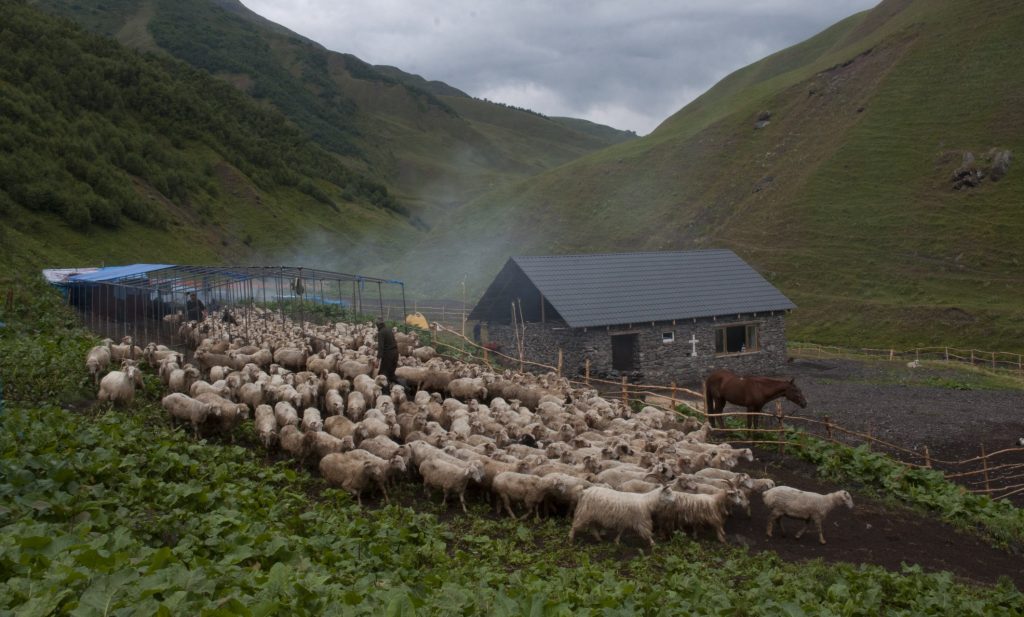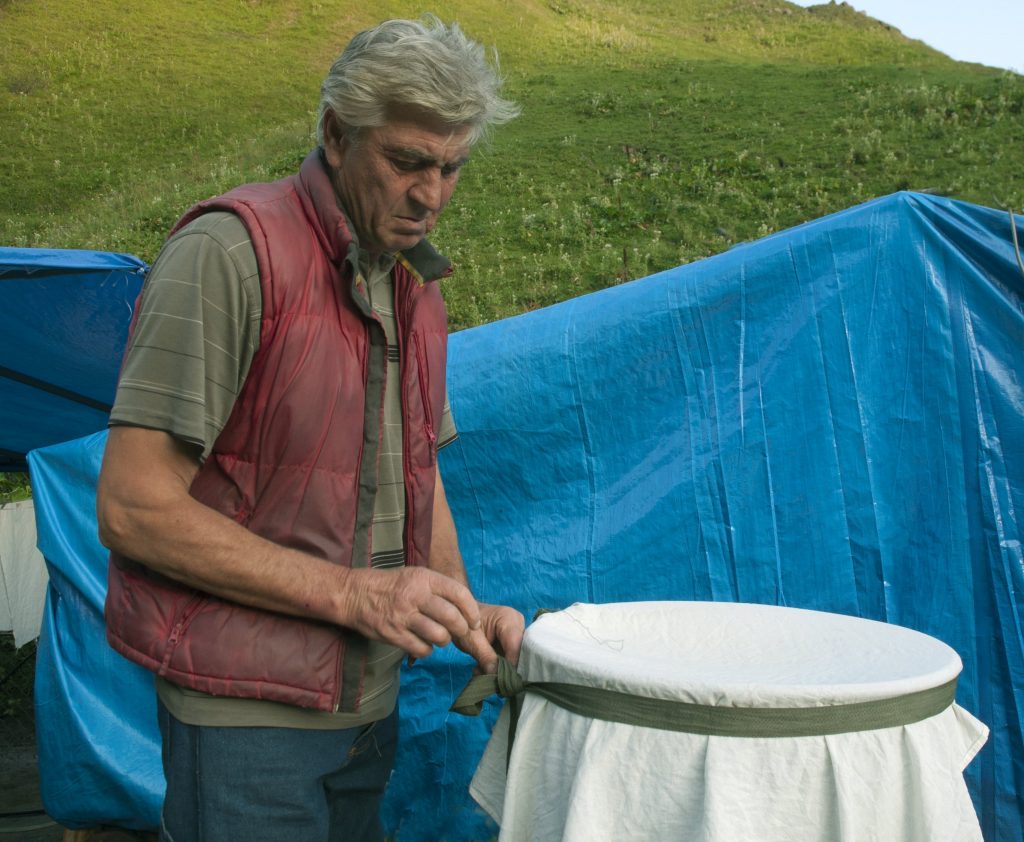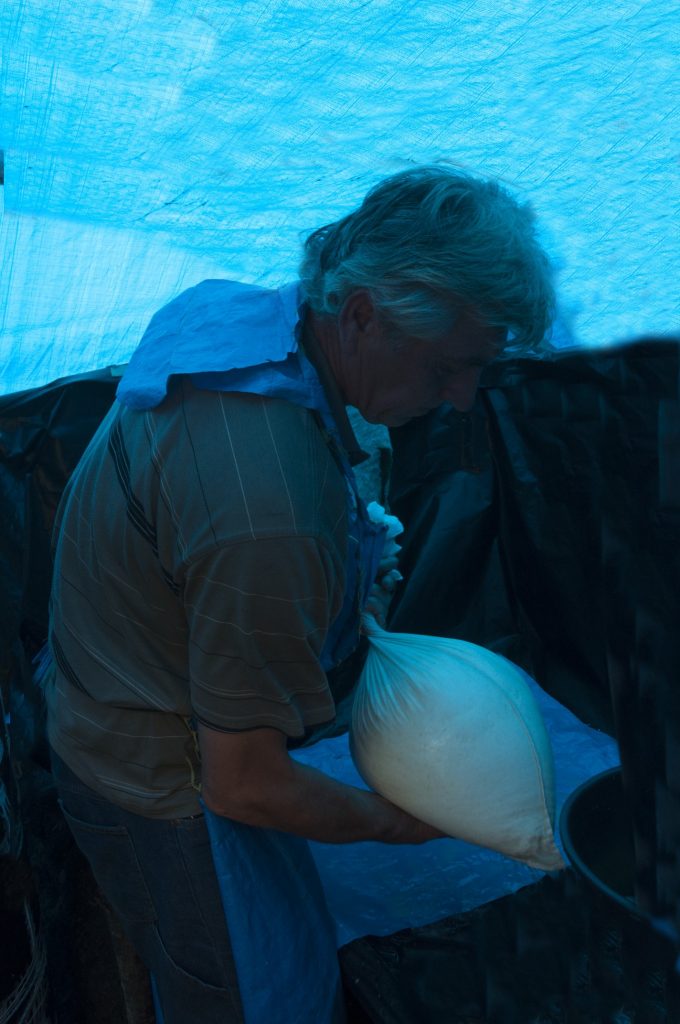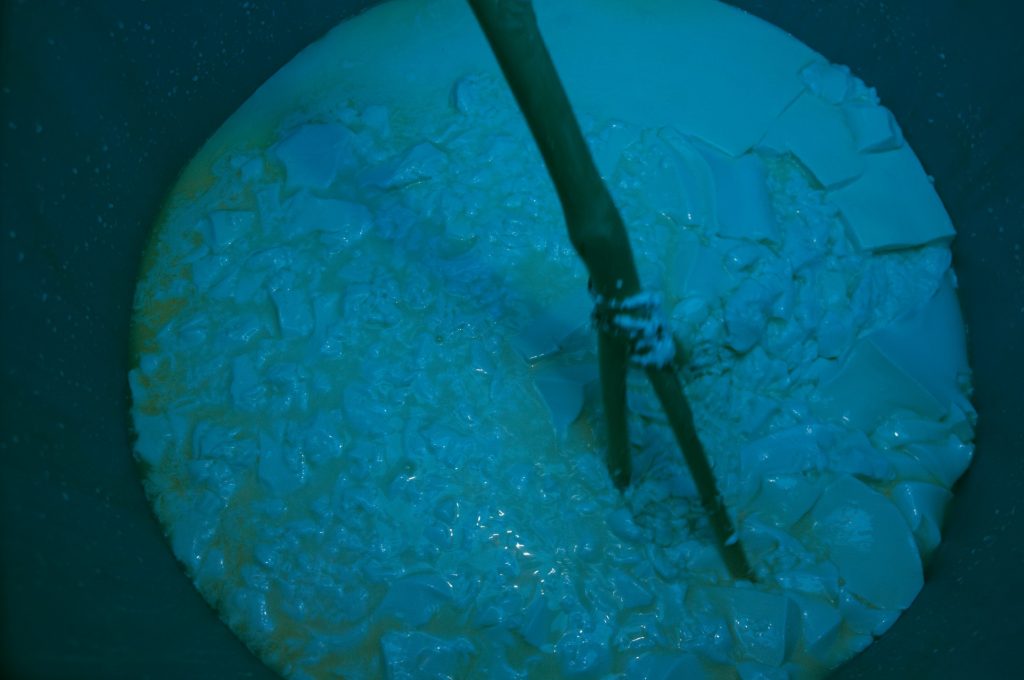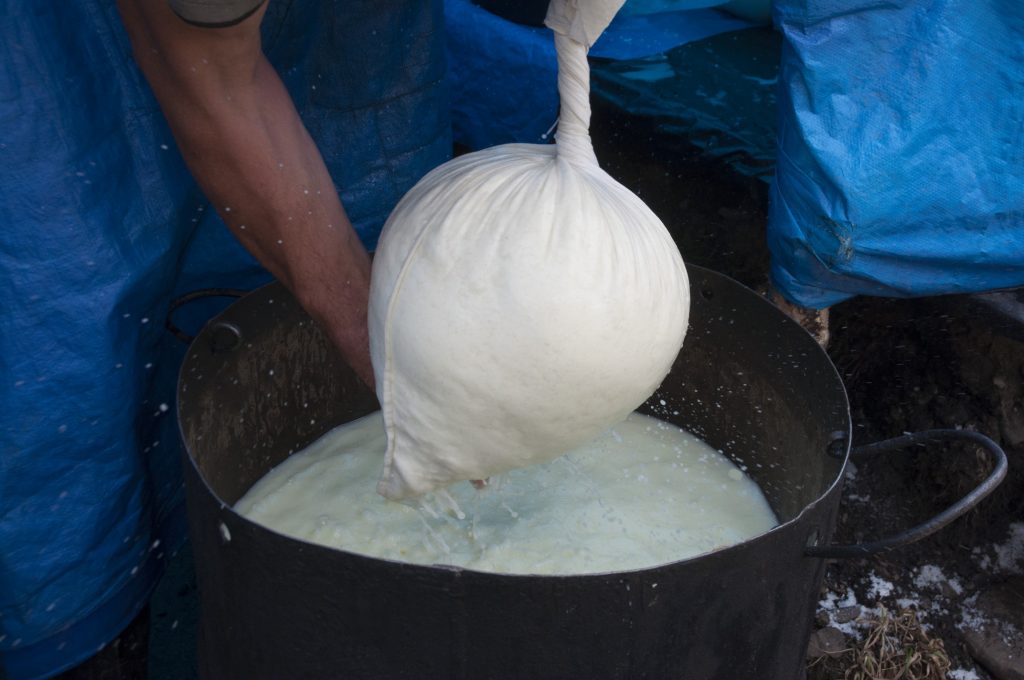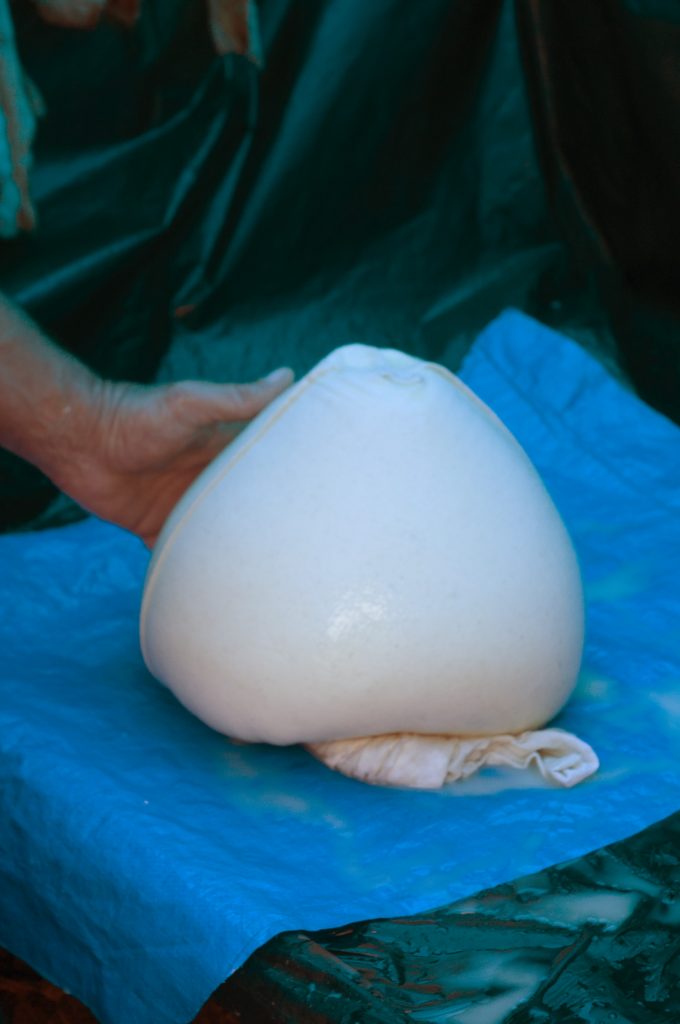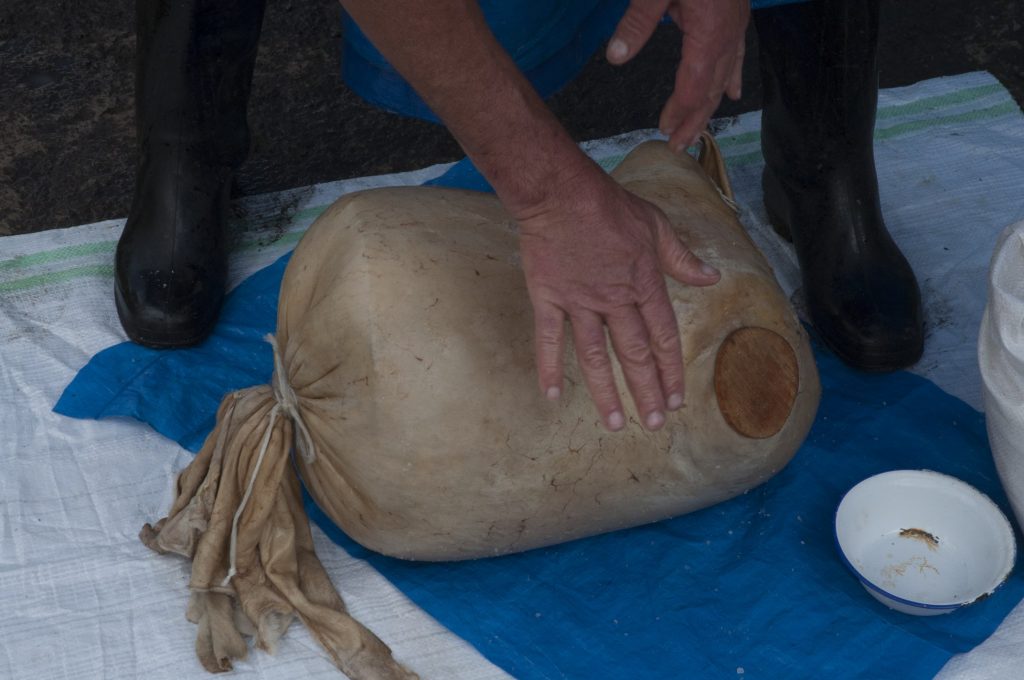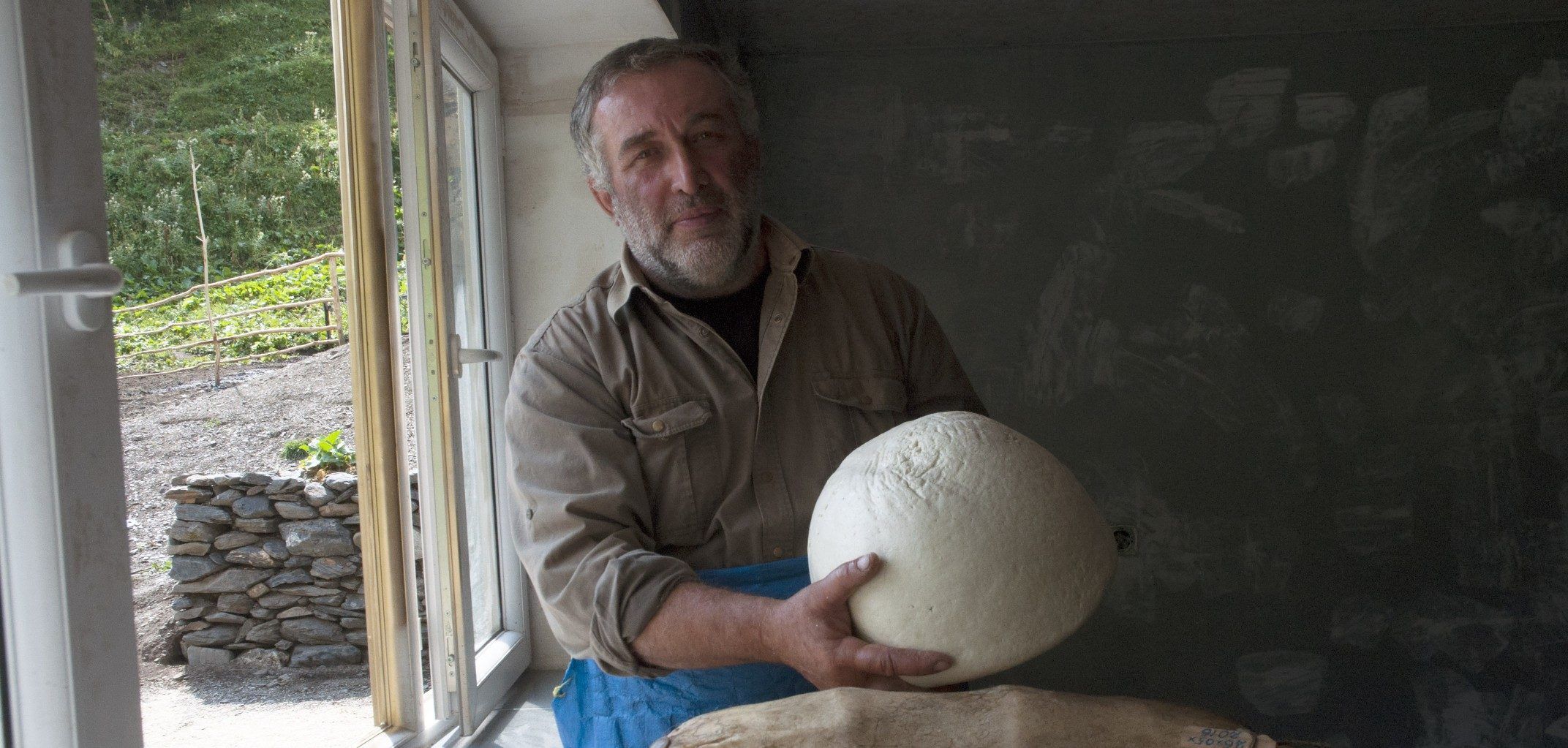
Tradition of Guda Cheese Production Comes Alive in Tusheti with EU Support – The Story of the Cooperative “Alaznistavi”
“My greatest achievement is that I have revived an almost forgotten tradition. Now this will continue and nothing will hamper the process.”
“Alaznistavi” farm is located some 2,100 metres above sea level in Alaznistavi, in the northeast region of Tusheti. Far from highways and spread out across traditional grazing grounds, the cooperative is surrounded by stunningly preserved pine forests and ancient villages in ruins. The members of the cooperative make Tushetian cheese the old-fashioned way.
Nomadic sheep breeding has always been a traditional occupation for the men of Tusheti and has played a role in the development of the local culture. The technology of Tushetian guda cheese production has been passed down from generation to generation. Matured in a guda – a traditional Georgian sack made from sheep or veal skin – the cheese boasts a truly distinct and unique flavor.
In the past 20-30 years, this centuries-old tradition has been replaced by plastic bags. Unfortunately, in the process, the cheese has lost its unique taste.
Chairman of the “Alaznistavi” cooperative Paata Abulidze is in love with Tusheti and its traditions, and his ancestors date far back in the region. He rekindled his connection to the region over 50 years ago.
“I spend four to five months in Tusheti every year”, he says.
Despite his roots, Paata Abulidze’s family lives in the Kakhetian village of Alvani these days. Gradually abandoned years ago, dating back to a process that began in World War II, Tusheti was reduced to some 100 families by the 50s.
Today, only border guards and some 10-12 families live full-time in Tusheti, even during the winter. They largely live in the village of Omalo, while the other 60 villages in the region take in residents only during the warmer seasons.
Families come back to Tusheti to manage guesthouses and other tourist facilities, and to graze sheep in summer. Paata also visits Tusheti on a seasonal basis.
He has practiced many professions. He was involved in sheep-breeding for several years during his studies. After completing basic training in the army, he studied veterinary medicine and furthered his studies in cattle-breeding.
Later he began producing and selling meat, for the purpose of which he moved to Georgia’s capital, Tbilisi. But the bustling city life got to him, and he wanted to return to rural life to continue cattle-breeding. Despite this, Paata kept an eye on developments on the market.
As a result of his long-term observations, Paata realised that there was a demand for organic products. After thinking carefully about several options open to him, he decided to revive the Tushetian tradition of guda cheese-making, which had long gone out of style.
„I have been involved in agricultural activities for years. While in Tusheti, I helped shepherds and accordingly I perfectly knew how to make traditional guda cheese” – noted Paata.
Enthusiastic about his idea, Paata acquainted himself with the appropriate legislation on food production and food safety standards. Given that this would be difficult to do while working out of a small hut, he decided to build a co-op where his production of guda cheese would be in compliance with international standards.
In 2015, Paata established an agricultural cooperative in Alaznistavi with the help of the EU-funded project “Supporting Agricultural Cooperation in Georgia” implemented by Oxfam under the European Neighbourhood Programme for Agricultural and Rural Development (ENPARD). With the EU support Paata was ready to make his next move.
The alpine and sub-alpine conditions of the local terrain in Tusheti made the location ideal for the production of Tushetian guda cheese. A production farm of cooperative was also placed there, where the farmers make cheese from sheep as well as cow milk.
Paata never thought of another location to produce his cheese.
“The only place where it is possible to make guda cheese is in Tusheti. The village is distinct because of its medieval origins and rock-dwellings, which are like refrigerators. There is a specific species of grass that grows here, and the difference between night and day-time temperatures is minimal. All of these factors leads to the highest quality of cheese production. This kind of cheese cannot be made in Pshavi, Khevsureti, Javakheti or any other area of the Caucasus. Tusheti is a place that has all the conditions needed to make authentic Tushetian guda cheese. Of course, cheese-production is easier in other places with a well-established electricity grid and telecommunications infrastructure, and where the roads do not often lead to tragic incidents. But we prefer to stay in Tusheti because we know that the grass is best here, there is natural refrigeration and other factors that help create the unique taste of guda cheese“.
The majority of “Alaznistavi” members are from Tusheti and are involved personally in the daily activities of the cooperative
As of today, the cooperative includes 11 members. The majority of them have their roots in Tusheti, but like Paata are also from Alvani. Most of them have earlier worked in cheese production and cattle-breeding. Some of the initial co-op members brought their wives in to help, and three women are now involved in the co-op’s activities.
It was not difficult for Paata and his friends to adjust to the peculiarities of making guda cheese. In centuries past, sheep-breeding and guda cheese making were one of the main activities of Tushetian men. Generally, the work was too intense for any one man to handle, and so seven to eight people were involved in an enterprise. Today, the agricultural cooperative serves the same function, and has the added bonus of official registration and certain other benefits.
The European Union allocated grant assistance worth over 98,500 GEL to the cooperative. In partnership with Oxfam, Paata’s cheese-production factory was built for the co-op with appropriate lighting and heating systems. The co-op members underwent trainings organised by Oxfam and the Biological Farming Association ELKANA, which helped them to better manage their business.
Members of the co-op are responsible for taking care of the sheep and cows, making cheese and gathering firewood. The chief responsibility is given to the head herdsman, who is an experienced specialist whose role it is to make cheese and supervise the milking of sheep. This is the only person who has the right to enter the cheese room – nobody else can take items from or into the room.
There is another manager at the cooperative who manages the production of cottage cheese. Yet another cleans the stalls where the sheep are milked, one person is responsible for firewood, someone else bakes bread and cooks, and so on. Every member of the cooperative has his or her specific duty, but sometimes they share in the collective work.
Paata Abulidze follows the cattle to pasture in both winter and summer.
“If you are not personally involved in these activities, it becomes more difficult to achieve your goal. Everyone has a different function, and if the owner doesn’t oversee the entire process, the business will not move forward. If you have 1000 or even 2000 sheep, you should be with the shepherd and supervise his work from time to time. You should do everything that the workers do – eat the same food, get warm the same way and go through the same difficult day’s work that they do. Otherwise, you’ll ruin the business” – Paata says.
The sheep spend the winter in the pastures of Shiraki and Eldari, while cows stay in the village of Alvani in the coldest season of the year. In spring, in mid-April, the cattle move off to pastures – first the sheep, which do not find it difficult to walk on bad roads from the valley to the mountains. In several days time, cows, which need less time to change their temporary shelter, also start moving off to pasture. From the beginning of May, cattle begin grazing again on Tusheti’s traditional grazing grounds.
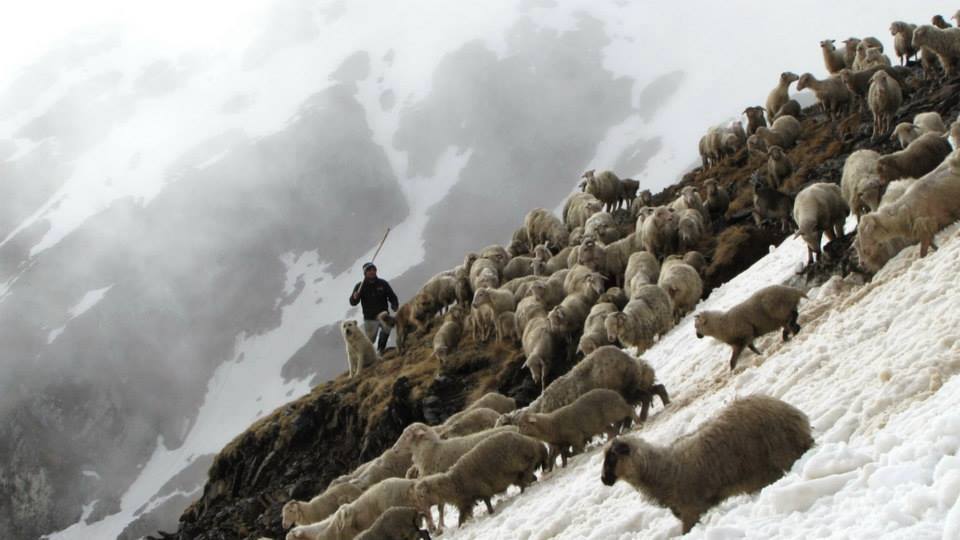
The milking of sheep and cows and the production of guda cheese also starts from this period. Over the course of four months, over 100-120 days, the full resources of the cooperative are mobilized in Tusheti. Wives also move from Alvani to Tusheti, taking their children with them for holidays.
The process of guda cheese-making is quite long and labor intensive. In “Alaznistavi”, about five people are responsible for milking some 500 sheep.
After collection, the milk is stored in a special tank, where its temperature is periodically measured. It is important to maintain the temperature of the milk at 37-40 degrees. Then the cooperative members pour lactic acid liquid in the milk, which they call dedo in Georgian. In about half an hour, a sticky liquid is created, which is known in Georgian as delema.
Cooperative members remove the serum from the liquid and fragment the delema.
After that, the liquid is removed from the vessel and the remaining cheese, which is about 8-9 kg, is cut and put in a canvas bag specially made for the cheese, which allows the cheese to take its round shape. The cheese is then put on a pad and covered with a felt cloak for half an hour to draw out the remaining serum. After that, the round-shaped cheese is placed in guda.
Over the course of 2-3 days, the guda cheese must be kept in a warm environment which is necessary for cheese fermentation. It is then relocated into a specially designed room, where it has to be turned around three times a day to change the shape. In order to ripen the cheese properly, it is kept for at least 60 days in a guda. In about 2 months time, the cheese is free of all kinds of bacteria and has an ideal taste.
The cheese produced from spring to late summer is stored in cool stores. At the end of August, the sheep are sheared and sent to pasture. Meanwhile, cooperative members collect enough food and wood for the shepherds to last them through the cold seasons. Starting in September, they transport cheese from Tusheti to Kakheti.
Taking into account the fact that “Alazsnitaive” warehouse is located some distance away, on traditional grazing grounds, first the horses take the produced cheese to the highway and then it is transported by vehicle. Once brought to Alvani, the guda is opened and the cheese is vacuum packed. Now the guda cheese is ready to be sold.
As of today, the cooperative owns about 600 cattle. Some of them are owned by the cooperative members. If this amount of cattle is not enough for production, cooperative members “borrow” animals from those people, who have animals but are not able to send them to graze and milk them. Alaznistavi has enough resources for these activities.
The growth in production of the cooperative, exports and the introduction of bio standards
The production of the cooperative has increased significantly in the last three years.
Today, ten tonnes of cheese are annually produced by the plant with the perspective of increasing output up to 20 tonnes in the near future. The cooperative does not have to pay additional expenses as they have their own animals and produce milk themselves.
The fact that suppliers, producers and sellers are united under one business is a great advantage of the “Alaznistavi” co-op. While the average profit per member of the cooperative was 1,000 GEL in 2015, this year it increased to 2,250 GEL.
In general, selling the produce is the most difficult thing for the entrepreneur, however “Alaznistavi” has never faced this challenge.
„Our product is in high demand and we do not find it difficult to sell it. We have not entered the supermarkets as we still do not have the proper resources to produce a high amount of cheese to supply the supermarkets systematically. However, we have acquired smaller trading networks, various small markets – we have private customers and also sell our cheese online.”
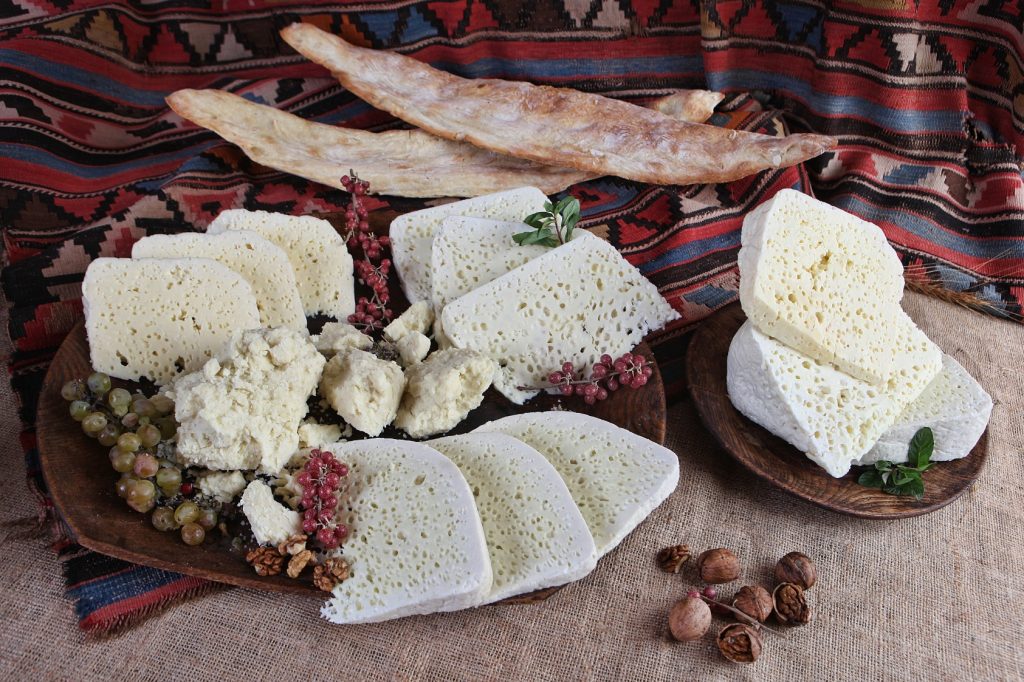
Alaznistavi’s prices are high: 1 kg cheese costs 25 GEL, but the price is worth the quality. The cooperative produces eco-friendly products in a traditional way.
“Some people prefer to go to the market and buy cheaper cheese, which is also called guda cheese. But 80 percent of guda cheese sold at local markets is not the real thing. There are many cases of inauthentic guda cheeses. Guda cheese made in the traditional way does not have a bad smell. On the contrary, it is distinguished by its pleasant aroma.”
After the information spread about the Alaznistavi, cheese producers in Tusheti became interested in the traditional cheese-making technology. Profit is one of their motivations, given that profit for the production of such cheese is about 30 percent higher. Also, it is easier to make investors interested in traditional cheese-making and accordingly, funding sources are more accessible. There are farmers who have already started producing guda cheese, while many of them plan changes in the future. During a recent seminar conducted by Swiss experts, about 50 percent of guda cheese producers are going to replace the plastic bag method with traditional production.
Alaznistavi often participates in different festivals and exhibitions. Part of the production is exported to the United States. It is important that there is growing interest towards guda cheese in Japan, Israel and different countries of Europe. However, there are some challenges which must be overcome by introducing bio-standard regulations in the manufacturing process.
Paata Abulidze says that the main challenge for the cooperative is that there is no cheese storage plant in the villages and surrounding towns. Since the cheese is brought from Tusheti to Alvani, it has to be transported in rather unsatisfactory conditions. It is very important for the whole region that a plant be constructed in accordance with food safety standards, where about 15 people will be employed and which will handle cheese storage, the opening of guda sacks, cutting cheese, packaging, labelling and so on. This will also increase the chances of selling guda cheese abroad.
There is also another direction which requires the implementation of bio-standards.
“My big wish is to winter at least 300-400 sheep, to have the chance to take animals to nearby pastures, milk them there and not to be forced to come into town. The sheep also suffer during transportation, during which time they have to cover about 300-400 km: they go from Tusheti to Kakheti, then arrive at the Azerbaijani border where they spend winter and eat grass poisoned with pesticides. As a result the sheep become ill with different diseases. The climate, land and grass are the best in Tusheti. There, sheep can graze in places where even man has not yet stepped. There is a perfect environment for producing organic products. But the fact that animals arrive in Kakheti, where there are many hindering factors, significantly hampers the implementation of bio-standards. Wintering in Tusheti would be perfect. The main thing to take into account is the collection of food supply for sheep and firewood for people and so on. However, investments are necessary for building roads and farms at traditional pasture land and for creating basic living conditions. It is difficult to attract investments. The city has become like a tadpole and it is necessary to encourage people to return to the village. To achieve this goal it is important to create certain conditions for them. Of course, I mean the road first of all, which is closed during the winter period and this place becomes isolated and inaccessible to people. Traditional pastures, which are so important for the cattle, are also hard to reach. The state’s involvement is necessary to prevent the erosion of the pastures,” says Paata.
The creation of the Association of Tushetian guda cheese producers and the protection of geographical indications
About 70 percent of works are already done for developing and promoting Geographic Indications (GIs) and other origin-based labels for guda cheese, which is supported by the European Union (EU) and the European Bank for Reconstruction and Development (EBRD), in partnership with the United Nations Food and Agriculture Organization (FAO).
Also, an association of guda cheese producers has been established, the main goal of which is to unite guda cheese producers, revive traditional cheese-making technology and protect the geographic indications of Tushetian guda cheese. The GIs certificate will determine how guda cheese is produced and what it should taste like.
The certificate will be granted only to those who produce high quality products. This will support the export and sale of cheese abroad and prevent cases of fraud on the market.
“Not everyone will have the right to label cheese as “Alvanis Guda”. This will be beneficial for high quality and real Tushetian guda cheese producers,” says Paata.
“Alaznistavi” is also interested in agro-tourism. Paata and his friends host tourists from different countries and introduce them to the specifics of Guda cheese-making. The cooperative plans to develop in this direction as well.
Reviving the old tradition is the biggest achievement for “Alaznistavi”. It is also notable that production has been increasing and improving day after day. In 2015, only 30 percent of produced cheese was guda cheese: today the cooperative is involved exclusively in the production of guda cheese.
Currently, “Alaznistavi” produces four types of traditional guda cheese: “Svilobi” – Tushuri sheep-milk guda cheese, “Lartusho” – cow-milk guda cheese, “Dovna” – sheep and cow milk mixed guda cheese, and “Chogi” – processed guda cheese.
Each type of guda cheese differs in its composition and gustatory qualities. Despite many challenges, the main wish of Paata Abulidze is to properly utilize the advantages of the Tusheti region.
„As soon as the grass grows and the smell of spring is in the air, I am drown to the village and the same feelings have the cattle also. I would stay in Tusheti during winter as well and would manage the complete production of Tushetian Guda cheese-making there,” says Paata.
By Thea Gvinadze


